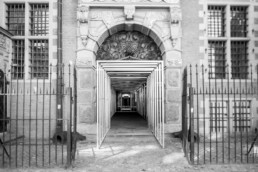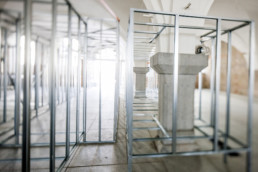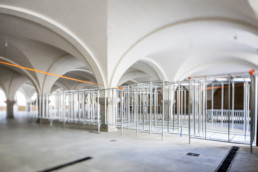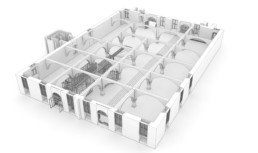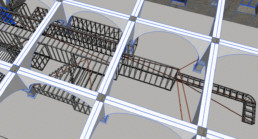The first shock of the great escape
exhibition
curator: Patrycja Ryłko
collaboration: Łukasz Jarząbek
expert consultant: Jacek Dominiczak
organiser: City Culture Institute
partner: Academy of Fine Arts in Gdańsk
The Gdańsk Academy of Fine Arts Grand Armoury, Targ Węglowy 6, 27 June–6 July 2014
A large-scale architectural installation which consisted in annexing a historical space and introducing functionalist elements therein: built from prototypes of the smallest elements acceptable in its architecture according to official norms. The piece was accompanied by a sound recurring in its space: a short and dull, shotgun noise, drawing attention to the paradox of employing maximum resources with minimum efficiency, and to the collision of the world of utopia with a historical actuality.
The installation is a headlining of a contentious contact area of two different and, simultaneously, temporarily and spatially exclusive narratives. The artists employs the matter of the building on 1:1 scale, completely annexing its pre-existing space: over 700 square metres of void, and over 400 years of history which have had a bearing on the internal organisation of its spatiality. She uses the scale in such a manner that it directly determines the actual size of her sculptural, temporal realisation. Intervening into the place, she re-defines its parameters by means of a partial introduction of ostensibly abstract spatial divisions, which in reality are defined divisions based on old formulas (architectural norms, initially recorded by Ernst Neufert in 1936, could be fitted into ci. 40 typed pages, while currently they cover over 800 printed pages) which regulated functionalism, understood here as the most economical and efficient way to create public space.
Inserting the geometrically elaborate structure into the pre-existing space of the Arsenal, she employs a void in a void, by means of abstract directives, mechanically determining the most programmatically and spatially complex objects of public use, and, therefore, employing the thoroughly instrumentalised and modularly fabricated norms of space dedicated for communal use, the artist opens up a discussion on the subject of functionalism as a limit of an organicity of use.
Krakowiak, treating functionalism as a physical limitation of space, defining it in terms of a systematised limit drawn to format an actual operability of a building, often counteracting its organic dynamics, underlines the complex relationship between the body of an object and its spatial contents, signifying capacity and functional capacities. In juxtaposing the two temporarily and spatially exclusive formulas regulating operations of space of the Arsenal, whose inner logic is, nowadays, certainly hardly understood or naturally employed, the artist uncovers clandestine codes of dependency, particularly those related to communicational incomprehension, dysfunction and the notion of error.
